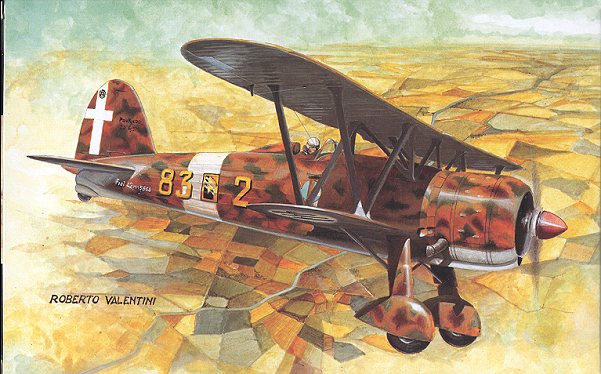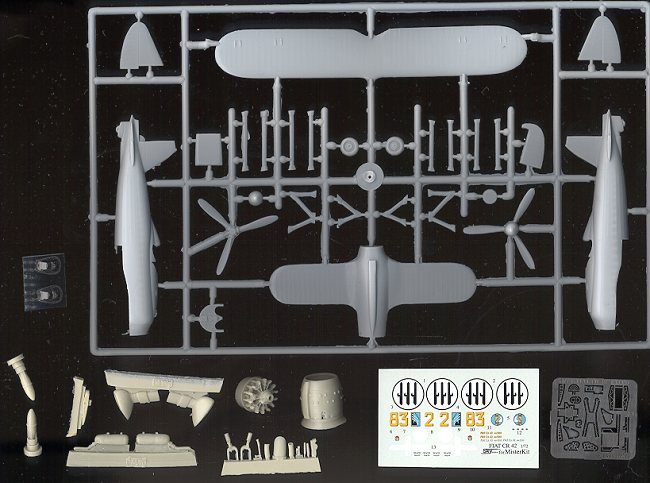
|
KIT: |
Misterkit 1/72 Fiat CR.42 |
|
KIT # |
72-01 |
|
PRICE: |
$28.49 |
|
DECALS: |
One aircraft of 83 Sq |
|
REVIEW & |
|
|
NOTES: |
Multimedia kit |

|
HISTORY |
The Fiat CR.42 has the distinction of being the last biplane fighter to be produced by any of the combatants during world war two. Developed from the CR.41 of 1936, this nimble little fighter began leaving the production line in 1939. Unfortunately for the CR.42, all of its opposition had abandon the biplane fighter concept years before and were producing much faster monoplane fighters. The Fiat biplane fighters were unusual in that they used a Warren-type interplane strut, which eliminated the flying wires so common with biplanes.
Typical of early war Italian fighters, the armament was meager, consisting of a 7.7mm and 12.5mm gun in the nose. Later versions deleted the 7.7mm gun for an additional 12.5mm, while late production aircraft had two additional 12.5mm guns in pods under the wings. In addition to Italy, the CR.42 was flown by Hungary, Belgium and Sweden.
The CR.42 flew against the French at the opening of Italy's war and, for a brief time, against the British from bases in Belgium. The aircraft was woefully inadequate against modern air forces. Where it was shown to be quite capable, was in the fighter-bomber role. In this mode it was called the CR.42 A.S. and was fitted with bomb racks under each wing capable of carrying a 100kg bomb. In this role it was not uncommon to have the wheel fairings removed to prevent mud building up in them. Unbelievably, the CR.42 was produced until 1942, by which time over 1,700 of the type had left the production line.
|
THE KIT |

MisterKit is one of the newer multimedia kit makers from Italy. For their first subject, they have picked the very popular Fiat CR.42. Prior to this kit, only the rather inaccurate Revell version was available in this scale while in 1/48 there is the Classic AIrframes kit, a model that has not had very good press.
The kit comes in an end-opening box that has very nice box art on it of the aircraft inside. Opening the end flap and pouring out the contents, you find a bag with a sprue of injected styrene parts along with a smaller bag of green-grey resin bits, two vacuformed windscreens, a small acetate sheet with the instrument panels on it, an etched metal fret and a small sheet of decals. You'll have to forgive all the 'small' references as I have been building in 1/48 for too long, it seems!
So, let's take a peek at the bits, OK? First the injected sprue. The panel line detailing is very petite; the fabric representation is quite good and not overdone. There are a few bits of flash and I did spot a small sink mark or two on the right fuselage half. No big deal as this is a short run kit and they are in 'safe' places. There are some large ejector pins in the fuselage and lower wing, but they will not interfere with construction. There are no locator pins on the fuselage nor are there any marks as to where to put the struts or landing gear.
The resin bits are all very nicely done. I could not see any air bubbles on any parts and flash is basically non existent. The resin parts are for the cowling, engine, landing gear, bomb racks, bombs, smoke canisters, and some interior bits. The etched metal fret is also well done and is mostly interior parts. The vacuformed windscreens are also nicely done and I do appreciate having a spare! Decals are for one aircraft and are superb. They should be as they are done by Sky Models.
Instructions are an eight page affair with a history on the first page, parts diagram on page two followed by three pages of construction. There are two decal and painting pages following and the end is a list of other kits by MisterKit. The instructions appear to be more than adequate to complete the kit. There are measurements given as to drill sized needed to open intakes as well as distances for attaching the wing struts. You do have to make a few of the smaller bits yourself, but nothing beyond the ability of an experienced modeler.
You basically have two options. One is for what you want to put under the wings (if anything). You have a choice of smoke generators or small bombs. The other option is to remove the wheel spats and use the resin gear forks for open landing gear. This was often used to prevent mud from building up in the spats. There is one painting option. That is for a sand yellow with brown and green mottling over a grey underside. You can model the plane as it was in Belgium or Libya. The Libyan plane is the one with the bombs.
All in all it appears to be a nice kit of the last of the
biplane fighters.
|
REFERENCES |
Warplanes of the Second World War: Fighters Vol. 2. William Green, 1961
If your local shop cannot obtain this kit, it can be purchased direct from the distributor at the link below.
Review kit courtesy of Pacific
Coast Models, Inc.
If you would like your product reviewed fairly and quickly by a site that has over 900 visits a day, please contact me or see other details in the Note to Contributors.